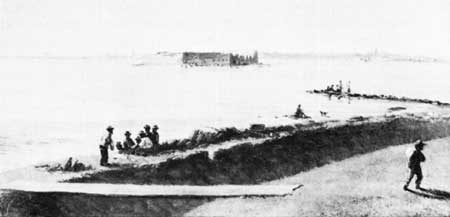|
FORT SUMTER National Monument |
 |

"Fort Sumter from Fort Moultrie, November 10, 1863"
painted by Conrad Wise Chapman.
Courtesy Confederate Museum,
Richmond.
The
Second Great Bombardment
On October 26, "on the strength of certain reports ... that the enemy have recently been at work remounting some guns," Gillmore resumed the bombardment; at least Fort Sumter could be "kept down" while the Navy prepared. For the next 12 days, the concentration of fire was comparable to the great bombardment of the preceding August. But now, firing from the new batteries on Cummings Point, with range shortened to less than a mile, the effect was far greater. For the first rime, 16 heavy mortars were in use—2 of them 8-1/2-ton pieces (13-inch bore) throwing 200-pound projectiles. Their sharp, plunging fire was added to that of 12 Parrott rifles—the types already used so effectively against the fort—and 1 powerful Columbiad. In addition, 2 monitors, with guns "equal to a dozen" Parrotts, crossed fire with Gillmore's artillery.
Sumter's "sea front" (right flank), upright and relatively unscathed till then, was breached now for nearly half its length. The ramparts and arches of its upper casemates were cut down and the interior barracks demolished. The accumulated debris made ascent easy inside and out. Through the breach, the Federal guns took the channel fronts "in reverse." For the first time, these were exposed to direct fire; soon they were "cut and jagged." Still, the gorge ruin remained much the same; to Admiral Dahlgren, that "heap of rubbish" looked "invincible."
Night and day, Gillmore's batteries maintained a "slow fire" against Fort Sumter throughout November and into December. On occasion the monitors assisted. Sumter could return merely "harmless musketry"; only telescopic rifle sights made even that much possible. But, the "rebels" seemed "snug in the ruins"; and if Sumter was without guns, Confederate batteries on James and Sullivan's Islands kept up an irritating counterfire.
On November 6, the Confederate engineer at Fort Sumter reported the bombproofs (quarters) unhurt. Although the height of the mass of the fort was "diminishing visibly on the sides away from the city," still, "when it gets down to the lower casemates [he wrote] it will have become so thick from accumulated debris as to resist further battering." Two weeks later, Major Johnson found the fort stronger than ever, and casualties were "either among those carelessly exposing themselves outside the bombproof or obliged to do so when at work." Indeed, casualties had been surprisingly low—only 2 men had been killed in the bombardment of August and only 22 more since the start of the second great bombardment; 118 had been wounded. Major Johnson did not "apprehend being run out by the big guns"; his chief anxiety was over "exposure to assault from barges at night."
In mid-November such an attack seemed to be forthcoming. During the early hours of the 18th, the defenders of the fort had "four distinct alarms" as small boats approached within hailing distance; "all hands out each time and expecting a fight." On the following night, a force estimated at 250 men approached within 300 yards of the fort, only to be driven off by the muskets of the aroused garrison.
But General Gillmore had merely ordered a "reconnaissance ... of the nature of a simulated attack, with a view to compel the garrison to show its strength." Nor would he make another attempt. The next move remained up to the Navy.
Admiral Dahlgren continued to make no move. In any event, he could not advance until the repairs on the monitors were finished. As late as January 1864 these still were not complete. Meanwhile, in the face of reports of greatly strengthened harbor fortifications other than Fort Sumter and increasingly concerned over the nature of the harbor obstructions he was reluctant now to move forward without additional monitors. Defeat was always possible, and defeat for the Union's "only ironclad squadron" might have serious consequences, not only for the blockade and Gillmore's command on Morris Island, but for future operations elsewhere along the coast. In the meantime "substantial" advantages had already been gained; the blockade at Charleston was tighter with Morris Island in Federal hands. To all this, the Navy Department agreed. Elsewhere, however, the war gathered momentum. In November, the North won decisively at Chattanooga.
The additional monitors, always promised, never seemed to arrive. On December 5, General Gillmore stopped the bombardment of Fort Sumter begun 41 days earlier. There seemed no great advantage in continuing, and it required considerable ammunition.

|
|
Last Modified: Mon, Dec 2 2002 10:00:00 am PDT |


